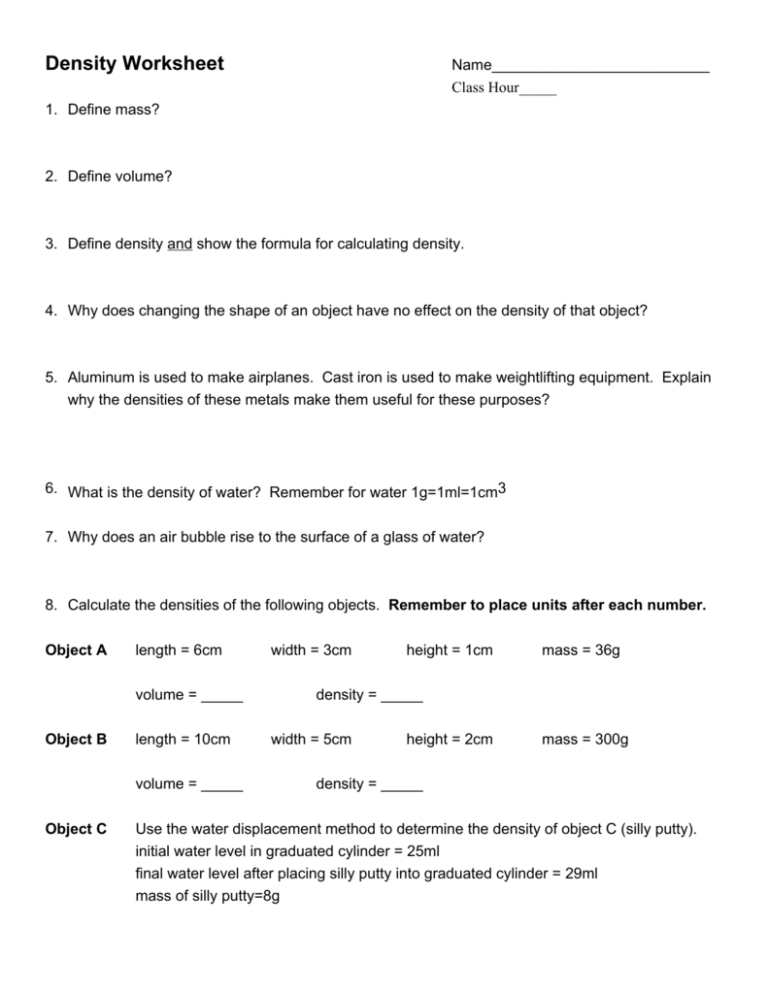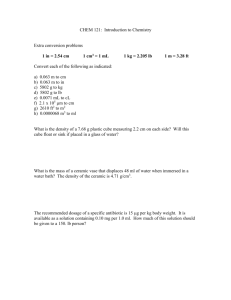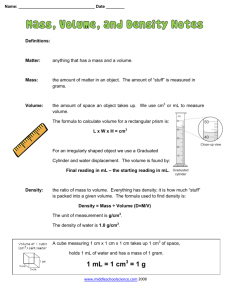Density Worksheet
advertisement

Density Worksheet Name__________________________ Class Hour_____ 1. Define mass? 2. Define volume? 3. Define density and show the formula for calculating density. 4. Why does changing the shape of an object have no effect on the density of that object? 5. Aluminum is used to make airplanes. Cast iron is used to make weightlifting equipment. Explain why the densities of these metals make them useful for these purposes? 6. What is the density of water? Remember for water 1g=1ml=1cm3 7. Why does an air bubble rise to the surface of a glass of water? 8. Calculate the densities of the following objects. Remember to place units after each number. Object A length = 6cm volume = _____ Object B length = 10cm volume = _____ Object C width = 3cm height = 1cm mass = 36g density = _____ width = 5cm height = 2cm mass = 300g density = _____ Use the water displacement method to determine the density of object C (silly putty). initial water level in graduated cylinder = 25ml final water level after placing silly putty into graduated cylinder = 29ml mass of silly putty=8g Name ___________________________ Period _________ Density Worksheet In order to receive full credit, you must show ALL work and circle your final answer. 1. 100 grams of a liquid completely fill a 200 mL bottle. What is the density of the liquid? 2. A solution has a density of 1.50 g/mL. How many grams are needed to obtain 10.0 mL of solution? 3. If a block of copper measures 2.00 cm x 4.00 cm x 5.00 cm and weighs 356 grams, what is its density? 4. The density of mercury is 13.6 g/mL. a. what is the mass of 8.20 mL of mercury? b. what volume would 120 grams of mercury occupy? 5. A piece of silver has a mass of 2800 grams and occupies a volume of 266 cm3. What is the density of silver? 6. A bottle has a capacity of 1.2 liters. If the density of ether is 0.74 g/mL, what mass of ether can the bottle hold? 7. A student pipets 5.00 mL of ethanol into a flask weighing 15.25 grams. She finds that the mass of the flask plus ethanol = 19.17 grams. Calculate the density of ethyl alcohol. 8. Peanut oil has a density of 0.92 g/mL. If a recipe calls for ¼ cup of peanut oil, what mass of peanut oil is required? (Hint: 1 cup = 237 mL). 9. A chemist needs 2.00 g of a liquid compound, which has a density of 0.718 g/mL. If the compound costs $5.67 per mL, how much will a 2.0 gram sample cost? 10. Suppose you find a chunk of what appears to be gold in the sand at the beach. Devise a simple experiment to determine whether or not you’ve struck it rich. Please list all lab equipment required and list the specific steps you would take. A volume = _____ density = _____ 9. Which of the following materials will float on water (density 1 g/ml)? air = corn oil = .001 g/cm3 .93 g/cm3 1.26 g/cm3 corn syrup = 1.38 g/cm3 wood = .85 g/cm3 glycerine = rubber = 7.81 g/cm3 1.34 g/cm3 ice = .92 g/cm3 water = 1.00 g/cm3 steel = 10. Assuming the materials don’t mix, show how the materials would "stack up" in a graduated cylinder. Draw and label your answer! Volume and Density WORKSHEET NAME________________________ Block_____ Date ___/___/___ In the SI system, volume can be expressed in two ways, one is in liters and the other as a unit of distance “cubed” such as cm3. When using distance the “cube” is because you must multiply a distance times a distance times a distance. It is very important that all three distances are in the same unit such as cm or m or mm. For a cube the formula is length X width X height. Once you have the volume and the mass, it is easy to calculate the density of an object, that is, the amount of stuff in a certain space. To find the density, the formula is mass/volume. Work the following problems for practice; you’ll need it on an upcoming lab and chapter test. 1. What is the volume of a box measuring 1mX5mX6m? (Remember units) 2. What is the volume of a box measuring 2cmX7cmX3cm? 3. What is the volume of a cube measuring 5cm on each side? You must have the correct UNITS in order to get credit! 4. What is the volume of a cube measuring 1cm on each side? 5. What is the volume of a box measuring 3cmX6cmX4cm? 6. What is the volume of a box measuring 8mmX10cmX5cm? (Be careful – units!) Icm3 is equal to 1mL or another way to put it is 1L = 1,000cm3. Convert your answers as required. 7. What is the volume in ml of a box measuring 2cmX3cmX4cm? 8. What is the volume in ml of a cube measuring 5cm on each side? 9. What is the volume in L of a box measuring 5cmX20cmX5cm? 10. What is the volume in L of a cube measuring 10cm on each side? 11. What is the volume in L of a cube measuring 1m on each side? For the next problems you’ll need to figure density. Remember that density is mass/volume. 12. An iron cube measures 10cmX10cmX10cm. What is its volume? 13. If the same iron cube weighs 7.9kg, what is its density in g/cm3? 14. What is the density of a cube of water measuring 2cmX4cmX1cm, with a mass of 8g? 15. What is the density of a block of wood measuring .9cmX2cmX6cm with a mass of 5.4g 16. What has the greater density, a cube of water measuring 1cmX1cmX1cm and having a mass of 1g, or a block of plastic measuring 2cmX3cmX1cm with a mass of 4g? Water has a density of approximately 1g/cm3. In fact icm3 of water used to be the standard for a gram. Objects will sink if their density is greater that water and will float if their density is less. For the following problems, decide if the block will sink or float. 17. A cube measuring 2cm on each side weights 5g, will it sink or float? 18. A block has a mass of 20g and measures 2cmX4cmX2cm, will it sink or float? 19. A hollow iron cube has measures 5cm on each side and has a mass of 20g. Will the iron cube sink or float? 20. A cube made of very old hard wood, has a mass of 45g and measures 6cm a side, will it sink or float?




